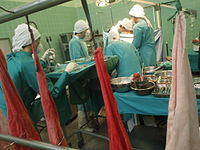
Photo from wikipedia
Abstract Objectives: To investigate the immunohistochemical features of different stages of BK virus allograft nephropathy (BKVN) and further elucidate the underlying immunological mechanism involved in the evolution of BKVN. Methods:… Click to show full abstract
Abstract Objectives: To investigate the immunohistochemical features of different stages of BK virus allograft nephropathy (BKVN) and further elucidate the underlying immunological mechanism involved in the evolution of BKVN. Methods: Fifty-two renal transplant recipients with biopsy proven BKVN were retrospectively selected. According to the third edition of the American Society of Transplantation Infection guidelines, 10 patients were categorized as having mild BKVN (stage A), 25 were moderate (stage B) and 17 were severe (stage C). The differential infiltrations of CD3+ (T lymphocytes), CD4+ (helper T lymphocytes), CD8+ (cytotoxic T lymphocytes), CD20+ (B lymphocytes), CD68+ (macrophages) and CD138+ (plasma cells) cells and the expression of interleukin-2 receptor (IL-2R) and human leukocyte antigen DR (HLA-DR) were compared among the three groups. Results: CD3+, CD4+, CD8+, CD20+, CD138+ and CD68+ cells infiltrations, IL-2R and HLA-DR expression were positive in the BKVN patients. Moreover, with increasing stages of BKVN, the numbers of positively stained inflammatory cells and the expression of IL-2R were significantly increased in the severe group compared to the mild group, whereas no statistically significant differences were observed with regard to HLA-DR expression. Eosinophil and neutrophil infiltration could also be observed in moderate to advanced BKVN. Conclusion: Renal allograft damage caused by BKVN involved T lymphocyte-, B lymphocyte- and mononuclear macrophage-mediated immune responses. Inflammatory cell infiltrations in the renal allograft were probably the driving force for BKVN progression. Additionally, eosinophils and neutrophils may be involved in the pathophysiological mechanism of BKVN.
Journal Title: Renal Failure
Year Published: 2019
Link to full text (if available)
Share on Social Media: Sign Up to like & get
recommendations!